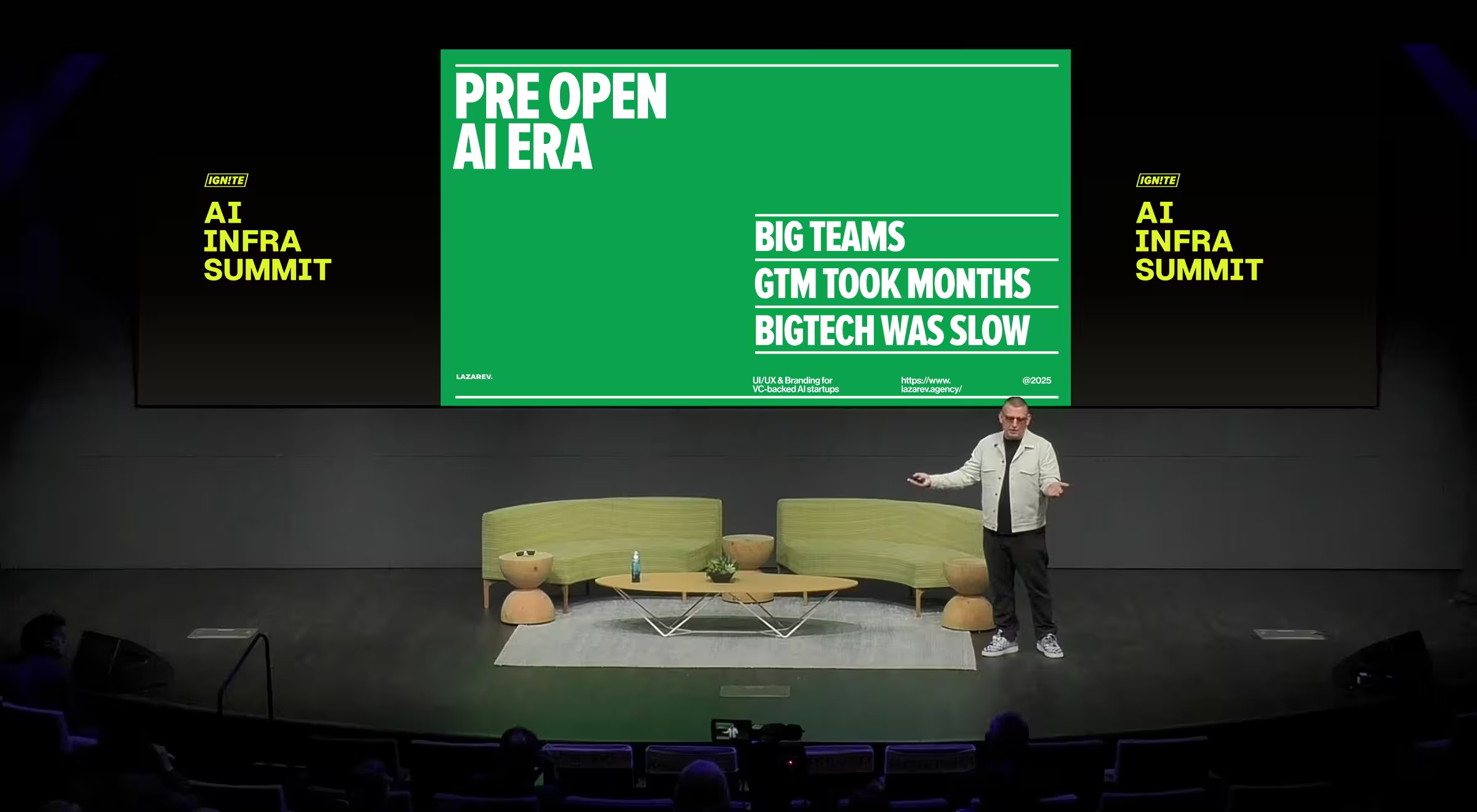Reviewed by: Lazarev.agency AI Product Experience Team
Last updated: December 2025
Expert sources: Lazarev.agency AI product case studies (news intelligence, financial research, next-gen search), AI INFRA Summit keynote by Kirill Lazarev, internal PX frameworks
In the age of AI, product experience design means treating the entire journey — from first impression to long-term engagement — as an intelligent, adaptive system built around user expectations. The products that win bake AI into their core logic, personalize by default, and design every interaction to build trust, clarity, and emotional connection.
Key takeaways
- PX > UX > UI. Interface and usability are now table stakes; the differentiator is the full product experience across time, channels, and states.
- AI is a core layer. Intelligence should shape flows, decisions, and personalization, not just power a single chatbot.
- Users arrive with expectations. Past products, AI hype, and emotional benchmarks frame how they judge your product before they click anything.
- PX = expectations + intelligent logic + interaction systems. It’s the discipline of shaping the relationship between people and intelligent products.
- Personalization goes default. In AI-native products, adaptation to role, context, and intent is expected.
- Design as a system. Map expectations, architect intelligence, blueprint interactions, design adaptive UIs, and validate trust.
Experience becomes the moat. When anyone can ship a feature in a week, PX is what turns intelligence into loyalty.

Why product experience design is the differentiator now
When technology can ship in days and AI-native tools feel like “10 developers on demand”, one thing still quietly determines whether a product survives: the experience.
Not just how it looks. Not just whether a task can be completed. But:
- How it feels to use
- How it behaves across contexts and sessions
- How much trust it earns over time
The old playbook was: build a solid feature set, ship, then optimize your “aha moment” — that instant where users realize, “this solves my problem.” If the value felt greater than the cost, the job was done.
Today, that’s the bare minimum:
- AI tools like v0 let non-technical people spin up front-ends in hours.
- AI coding copilots like Cursor feel like adding extra developers to your team.
- Product creation is cheaper, faster, and noisier than ever.
That means the only thing: trust is harder.
When anyone can launch something in a weekend, users become more skeptical. They’ve seen buggy AI launches, overpromises, and abandoned products.
Functionality still matters but product experience is the only durable differentiator.
What do users expect from your product in 2026?
Every user arrives with pre-set expectations:
- From the last app that “just worked”
- From the AI hype cycle and media stories
- From your category leaders and their best moments
They don’t meet your product neutral. They bring:
- Emotional benchmarks (“I expect this to feel as smooth as my favorite tools.”)
- Functional expectations (“I expect AI to understand context and not repeat basic mistakes.”)
- Contextual assumptions (“I assume this will work across devices, channels, and tools I already use.”)
Two key truths:
- Expectations start before the first click.
Positioning, brand, pricing, and word-of-mouth set the bar before users see your UI. - Expectations drive perceived value.
The same feature can feel magical or disappointing depending on what users thought they were getting.
PX accepts this reality and asks:
“Given what users already believe and expect, how should this product behave to feel credible, intelligent, and worth their time?”
🔍 For a broader view on where product design is heading in 2026, read our guide to the future of product design.
How has the market’s mental model shifted?
Call it the “OpenAI era” versus the “AI-native era.”
Before:
- A typical SaaS launch meant: raise funding, hire 6+ devs, build for 6–18 months, ship.
- Big tech moved slowly; startups could win by simply being faster and more focused.
- The goal was one clear aha moment: “This solves my problem; I’ll pay.”
You could afford to focus on one core pain point and still stand out.
Now:
- AI-native tools let you generate UI, write code, and test prototypes at breakneck speed.
- Products can be shipped in weeks, sometimes days.
- Users know this, and their standards have moved.
This is the way we get a landscape with more products and more noise, but far less automatic trust. The “aha moment” still matters, yet it no longer closes the deal. Users now pause and ask themselves:
- Will this work for me?
- Will it keep getting better?
- Can I rely on it when it counts?
Those questions live squarely in the domain of product experience design — the discipline that turns first impressions into long-term confidence.
So, what is product experience design (PX)?
We call the new approach product experience design (PX).
PX goes beyond screens (UI) and beyond flows (UX). It’s the discipline of shaping the entire relationship between people and intelligent products.
PX focuses on three core layers:
- AI as the core
AI isn’t a widget in the corner. It’s part of your product’s decision-making, logic, and service delivery. - Mapping all pain points
Not just the one that brought users in. PX anticipates friction across the whole journey — onboarding, daily use, recovery, support, renewal. - Personalization by default
Products are expected to:- Adjust in real time to user behavior
- Communicate via intelligent AI agents
- Share context across surfaces for a seamless experience
Working definition:
Product experience design is the discipline of shaping the full journey a user has with an intelligent product — from discovery to long-term use — by aligning user expectations, AI-powered logic, and interaction systems into one coherent, trustworthy experience.
PX vs UX vs UI: how are they different?
PX doesn’t replace UX or UI. It layers over them, asking:
- “What does this product promise?”
- “How does intelligence show up at every step?”
- “What does it feel like to live with this product over months and years?”
🔍 For a complete framework built for the AI-native era, read our guide to how to build better AI products.
The updated PX framework: data + needs + UI
The future of products is a pre-customized data layer wrapped in the right UX and UI.
We at Lazarev.agency frame it as: Data + Needs + UI.
- Data
- Signals from behavior, preferences, past actions, and context
- The foundation for personalization, prediction, and proactive assistance
- Needs
- Real user jobs-to-be-done
- Emotional, functional, and contextual expectations
- Pain points across the whole journey, not just the first use case
- UI
- The visible, tangible layer where intelligence expresses itself
- Controls, feedback, and language that make AI feel understandable and safe
Great PX happens at the intersection:
Tech stack alone doesn’t win. Branding alone doesn’t win.
Data + Needs + UI, tightly aligned, create a product experience people remember.
🔍 If you want to see how this PX formula evolves into predictive, pre-emptive experiences, explore our deep dive on anticipatory design — the next major shift in AI-driven UX.
How to design for the age of intelligent products: 5 components
At Lazarev.agency, an AI product design agency, we treat PX as a system with five basic components.
1. Expectation mapping
Questions:
- How does the user expect this product to behave?
- What similar tools are they comparing you to?
- What do they assume AI will do for them?
- What would count as “this feels smarter than my current process”?
2. Intelligence architecture
Questions:
- Where should AI act autonomously (e.g., background automation)?
- Where must it ask for confirmation (e.g., money, security, legal)?
- Where must it explain itself (e.g., recommendations, risk scoring)?
This is how you define the “AI contract” with users.
3. Interaction blueprinting
Question: How should intelligence express itself?
- Visually (badges, hints, summaries)
- Verbally (tone of assistants, explanations, prompts)
- Contextually (what it knows, what it doesn’t, what it asks for)
4. Adaptive UI design
Question: How should the interface respond to state, role, and intent?
- Role-based experiences (beginner vs expert, analyst vs manager)
- State-aware screens (first time vs power user, low-risk vs high-risk flows)
- Intent-aware layouts (explore vs execute vs troubleshoot)
5. Experience validation
PX tests go beyond “Can users do X?” and ask:
- Do users trust what the AI is doing?
- Is the experience clear when AI is right and when it’s wrong?
- How do users feel after a session — confident, anxious, confused, impressed?
This is the craft of PX: shaping the relationship between people and intelligent systems.
🔍 If you’re looking for teams that apply these PX principles at scale, our roundup of the best AI design agencies is a strong starting point.
Final thoughts: PX is how you stand out
When anyone can ship a product in a week:
- Branding alone isn’t enough.
- Features alone aren’t enough.
- Speed alone isn’t enough.
The only sustainable differentiator is how your product feels to use over time — how predictable, fair, intelligent, and trustworthy it is.
At Lazarev.agency, we’ve been designing AI-powered products since 2017 — long before “AI-first” was a slide in every pitch deck. From financial research tool to news intelligence platform to next-generation search, our work keeps proving one principle:
PX is what turns intelligence into value.
If you want to build an AI-native product people return to, not just try once:
Let’s talk about your product experience.
We’ll help you map expectations, architect intelligence, and design PX that earns trust in the age of AI.
This article is based on Kirill Lazarev’s speech at the AI INFRA Summit. Watch the full talk for a deeper dive into PX patterns and AI-native product strategy.





























.webp)













.avif)
%20(1).avif)
.avif)
%20(1).avif)
%20(1)%20(1).avif)
.avif)
